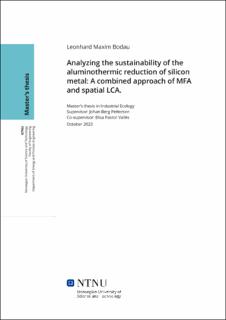| dc.description.abstract | Achieving carbon neutrality by 2050 is a multi-disciplinary challenge requiring innovation and transformation in all industrial sectors. The silicon metal production is an energy and carbon intensive process emitting upwards to 12 metric tons of CO2 per 1 ton of silicon metal produced. The SisAl pilot patented a novel production process using secondary aluminium as a reducing agent and thereby aims to decarbonize the silicon metal production. This thesis uses material flow analysis to quantify the mass flows of the aluminothermic reduction and life cycle assessment to evaluate its sustainability. It uses a spatial approach for transport distances, electricity inputs, and its impact categories to assess the environmental impact of four business cases and a baseline scenario. It compares them with the conventional production and an earlier assessment of the aluminothermic reduction. The assessment shows that taking these parameters into account doubles the overall impact of the aluminothermic reduction compared to earlier assessments and makes them comparable to the conventional production. Especially the consideration of country-specific electricity mixes increases the impact substantially. Additionally, the comparison of regional characterization factors with the global average changes the impact categories ozone formation: ecosystems and freshwater eutrophication by a factor of two, showing that a spatial LCA modifies the outcome of the impact assessment. The assessment shows that a careful consideration of the spatiality in the inventory is key for a comprehensive evaluation of this system. In the upcoming years the silicon metal production needs to be further analysed taking the regional differences into account and improving upon the circularity of the aluminothermic reduction. | |
